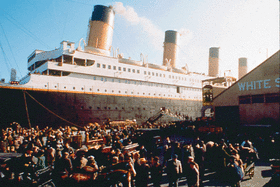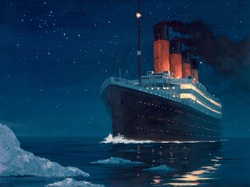When the Titanic was built, it was believed to be unsinkable. They had built 16 watertight chambers, so if any water had entered the boat, the ship wouldn't sink.
However, when the front of the Titanic scraped the side of the ice burg, and at the velocity they were going, it made just enough of an impact to break the rivets and flood the first five chambers.
The weight of the water in the front of the boat began to cause problems. More compartments began to flood, which weighed down the ship even more.
When the water entered the boat, it added more weight pushing down against the water. The Titanic was heavier than the amount of water it displaced, so it wasn't able to stay afloat.
With so much weight on the front, the back came up out of the water so the Titanic was tilted. The end of the ship snapped off from the front, allowing the front to head straight to the bottom of the ocean.
However, when the front of the Titanic scraped the side of the ice burg, and at the velocity they were going, it made just enough of an impact to break the rivets and flood the first five chambers.
The weight of the water in the front of the boat began to cause problems. More compartments began to flood, which weighed down the ship even more.
When the water entered the boat, it added more weight pushing down against the water. The Titanic was heavier than the amount of water it displaced, so it wasn't able to stay afloat.
With so much weight on the front, the back came up out of the water so the Titanic was tilted. The end of the ship snapped off from the front, allowing the front to head straight to the bottom of the ocean.

Forces involved in the Sinking Titanic
-Potential Gravitational Energy: gravity was pulling the boat down towards the water
-Kinetic Mechanical Energy: the ship had kinetic mechanical energy because it was in motion.
-Buoyancy: the weight of the Titanic was heavier than the amount of water it displaced, causing the ship to sink
-Archimedes Principle: learn what determines if a ship will float or sink
-Potential Gravitational Energy: gravity was pulling the boat down towards the water
-Kinetic Mechanical Energy: the ship had kinetic mechanical energy because it was in motion.
-Buoyancy: the weight of the Titanic was heavier than the amount of water it displaced, causing the ship to sink
-Archimedes Principle: learn what determines if a ship will float or sink

More cool stuff about the Titanic:
-Click here to play a game
-Click here to watch simulation
-Click here for more information on buoyancy
-Click here to play a game
-Click here to watch simulation
-Click here for more information on buoyancy
